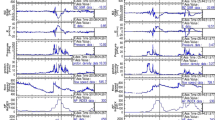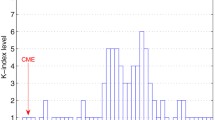Abstract
SYM-H is one of the important indices for space weather. It indicates the intensity of magnetic storm, similarly to Dst index but with much higher time-resolution. In this paper an artificial neural network (ANN) of Nonlinear Auto Regressive with eXogenous inputs (NARX) has been developed to predict SYM-H index from solar wind and IMF data. In comparison with usual BP and Elman network, the new NRAX model shows much better prediction capability. For 15 testing great storms including 5 super-storms of Min. SYM-H < −200 nT, the cross-correlation of SYM-H indices between NARX network predicted and really observed is 0.91 as a whole. For the 5 individual super-storms, the lowest coefficients is 0.91 relating to the super-storm of March 2001 with Min. SYM-H of −434 nT; while for the two super-storms with Min. SYM-H ranging from −300 nT to −400 nT, the correlations reach as high as 0.93 and 0.96 respectively. The remarkable improvement of the model performance can be attributed to such a key feedback from the network output of SYM-H with a suitable length (about 120 min) to the input, which implies that some information on the quasi real-time ring currents with a proper length of history does its work in the prediction. It tells us that, in addition to the direct driving by solar wind and IMF, the own status of the ring current plays an important role in its evolution especially for recovery phase and must properly be considered in storm-time SYM-H prediction by ANN. The neural network model of NARX developed in this paper provides an effective way to achieve it.
Similar content being viewed by others
References
von Humboldt A. Die vollstaendigste aller bisherigen Beobachtungen ueber den Einfluss des Nordlichts auf die Magnetnadel. Ann Phys, 1808, 29: 425–429
Chapman S, Ferraro V C A. A new theory of magnetic storm, Part 1: the initial phase. Terr Mag Atmos Elec, 1931, 36(2): 77–97
Gosling T J. The flare myth. J Geophys Res, 1993, 98: 18937–18949
Kamide Y, McPherron R L, Gonzalez W D, et al. Magnetic storms: Current understanding and outatanding questions. In: Tsurutani B T, Gonzalez W D, eds. Magnetic Storm. Geophys Monogr, Ser 98. Washington: AGU, 1997. 1–19. 12
Gonzalez W D, Joselyn J A, Kamide Y, et al. What is a geomagnetic storm? J Geophys Res, 1994, 99: 5771–5792
Tsurutani B T, Gonzalez W D. The interplanetary causes of magnetic storms: A review. In: Tsurutani B T, Gonzalez W D, eds. Magnetic Storm. Geophys Monogr, Ser 98. Washington: AGU, 1997. 77–89
Daglis I A. The role of magnetosphere-ionosphere coupling in magnetic storm dynamics. In: Tsurutani B T, Gonzalez W D, eds. Magnetic Storm. Geophys Monogr, Ser 98. Washington: AGU, 1997. 107–116
Daglis I A. Ring current dynamics. Space Sci Rev, 2006, 124: 183–202
Sugiura M, Poros D J. Hourly values of equatorial Dst for the IGY. Ann Int Geophys Year, 1964, 35: 9–45
Mayaud P N. Derivation, Meaning, and Use of Geomagnetic Indices. Geophysical Monograph 22. Washington D.C.: American Geophysical Union, 1980
Wanliss J A, Showalter K M. High-resolution global storm index: Dst versus SYM-H. J Geophys Res, 2006, 111: A02202
Amata E, Pallocchia G, Consolini G, et al. Comparison between three algorithms for Dst predictions over the 2003–2005 period. J Atmos Sol-Terr Phys, 2008, 70: 496–502
Burton R.K, McPherron R L, Russell C T. An empirical relationship between interplanetary conditions and Dst. J Geophys Res, 1975, 80: 4204–4214
Wang C B, Chao J K, Lin C H. Influence of the solar wind dynamic pressure on the decay and injection of the ring current. J Geophys Res, 2003, 108(A9), 1341, doi: 10.1029/2003JA009851
Baker D N. Statistical analyses in the study of solar wind/magnetosphere coupling. In: Kamide Y, Slavin J A, eds. Solar Wind-Magnetosphere Coupling, vol 17. Dordrecht: D Reidel Publishing Company, 1986
Wu J, Lundstedt H. Prediction of geomagnetic storms from solar wind data using Elman recurrent neural network. Geophys Res Lett, 1996, 23(4): 319–322
Wu J, Lundstedt H. Geomagnetic storm predictions from solar wind data with the use of dynamic neural networks. J Geophys Res, 1997, 102: 14255–14268
Lundstedt H, Gleisner H, Wintoft P. Operational forecasts of the geomagnetic Dst index. Geophys Res Lett, 2002, 29(24), 2181, doi: 10.1029/2002GL016151
Pallocchia G, Amata E, Consolini G, et al. Geomagnetic Dst index forecast based on IMF data only. Ann Geophys, 2006, 24: 989–999
Zhou Y L, Ma S Y, Luehr H, et al. An empirical relation to correct storm-time thermospheric mass density modeled by NRLMSISE-00 with CHAMP satellite air drag data. J Adv Space Res, 2008, doi: 10.1016/j.asr.2008.06.016
Elman J L. Finding structure in time. Cogn Sci, 1990, 14: 179–211
Haykin S. Neural Networks: A Comprehensive Foundation, 2nd ed. New Jersey: Prentice-Hall Inc, 1999
Author information
Authors and Affiliations
Corresponding author
Additional information
Supported by Doctoral Fund of Ministry of Education of China (Grant No. 200804860012)
Rights and permissions
About this article
Cite this article
Cai, L., Ma, S., Cai, H. et al. Prediction of SYM-H index by NARX neural network from IMF and solar wind data. Sci. China Ser. E-Technol. Sci. 52, 2877–2885 (2009). https://doi.org/10.1007/s11431-009-0296-9
Received:
Accepted:
Published:
Issue Date:
DOI: https://doi.org/10.1007/s11431-009-0296-9




